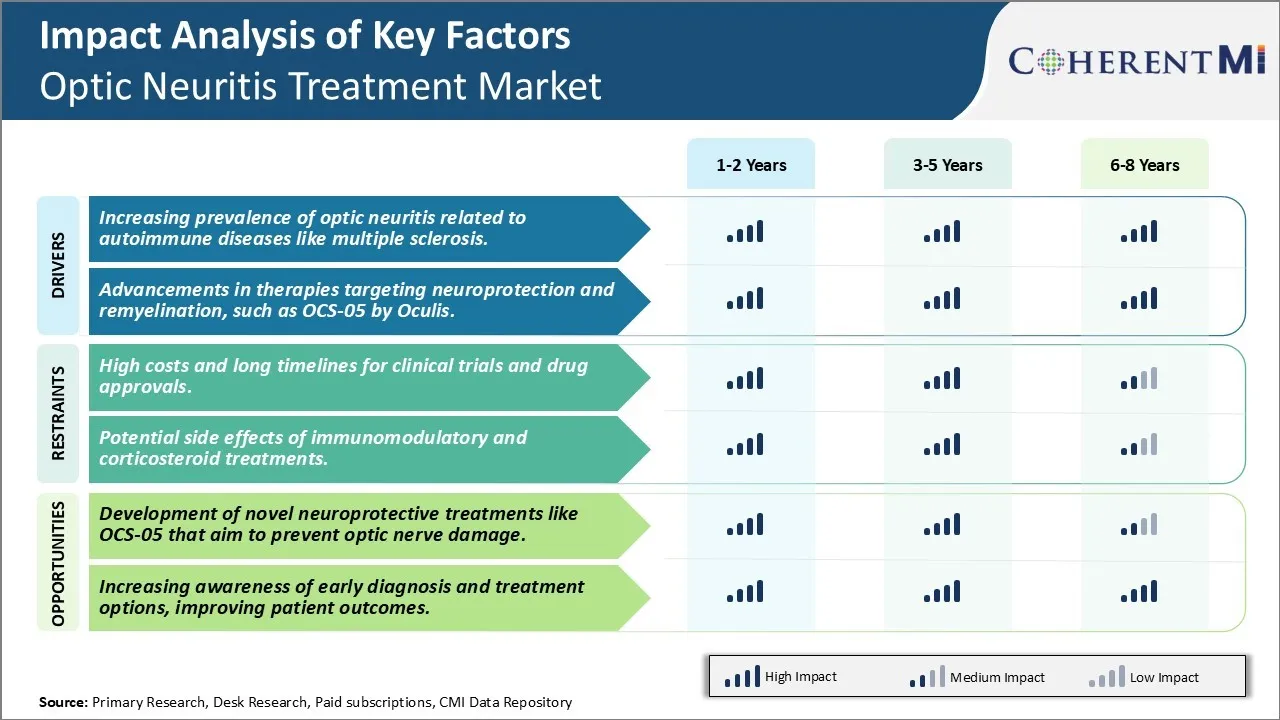Optic Neuritis Treatment Market Trends
Market Driver - Increasing Prevalence of Optic Neuritis Related to Autoimmune Diseases Like Multiple Sclerosis.
The increasing prevalence of optic neuritis globally, especially those associated with autoimmune diseases like Multiple Sclerosis (MS) has been a key driver augmenting the growth of optic neuritis treatment market. Optic neuritis is an inflammation of the optic nerve leading to temporal or permanent vision loss and pain in the affected eye. It is highly prevalent in patients affected with multiple sclerosis where it is one of the earliest and most common symptoms presenting in about 25-50% of MS patients.
With nearly 2.3 Mn people affected by multiple sclerosis worldwide, its prevalence has been rising gradually over the years. For instance, according to various studies and surveys, the prevalence rate of MS in North America and European countries such as United States, Canada, Germany and Italy have grown by 10-30% from the last three decades. This is mainly attributed to improved diagnostic capabilities and increased environmental risk factors in these regions. MS predominantly affects young adults in their 20s and 30s, so as this patient base continues to expand, so does the risk of optic neuritis. As there is no permanent cure available for MS, patients require long-term management of symptoms throughout their lives which further augments the need for effective optic neuritis treatment options.
While optic neuritis attacks associated with MS are usually unilateral, repeated attacks or bilateral involvement can severely hamper vision. Therefore, early diagnosis and timely intervention play a vital role in managing optic neuritis cases, restoring vision and preventing progression to functional blindness. With limited self-recovery possibility in chronic cases, pharmaceutical treatment gains more significance. This has propelled drug manufacturers to invest in developing more efficacious therapies targeting the underlying causes of optic neuritis like neuroinflammation and demyelination.
Market Driver - Advancements in Therapies Targeting Neuroprotection and Remyelination, Such as OCS-05 by Oculis.
One of the major drivers boosting the optic neuritis treatment market is the promising breakthroughs in pharmacological therapies that are centered on mechanisms of neuroprotection and remyelination. Among these, Paris-based Oculis' lead candidate drug 'OCS-05' holds huge potential as a first-in-class neuroprotective agent for optic neuritis as well as other ophthalmic and neurological diseases. OCS-05 acts by inhibiting Rho kinase (ROCK) which reduces axonal damage, inflammation and stimulates repair pathways like remyelination.
In preclinical studies, OCS-05 has demonstrated strong neuroprotective effects through substantial inhibition of axonal degeneration following acute optic nerve damage induced by various stimuli. It was also found to promote remyelination and enhance nerve conduction in mouse models of multiple sclerosis and optic neuritis. Encouraged by these results, Oculis has advanced OCS-05 into clinical trials where it has shown good safety and tolerability profile in healthy volunteers so far. The company is actively recruiting patients for Phase 2a randomized controlled trials in optic neuritis and neuromyelitis optica spectrum disorder.
Positive outcomes from ongoing and planned clinical efficacy studies can validate OCS-05's role in neuroprotection, preventing permanent vision impairment and hastening recovery in optic neuritis. Its once-daily topical ocular formulation offers notable advantages over frequent invasive injections. If approved, OCS-05 is expected to get preference over existing treatments owing to its novel mechanism, improved efficacy and enhanced convenience. This makes it a promising drug candidate to disrupt the current optic neuritis management landscape and drive significant revenues in the global market in the upcoming years.

Market Challenge - High Costs and Long Timelines for Clinical Trials and Drug Approvals.
One of the major challenges faced by companies operating in the optic neuritis treatment market is the high costs associated with clinical trials and lengthy drug approval timelines. Developing a new drug and getting it approved is an expensive and time-consuming process. On an average, it takes 10-15 years for a drug to be developed, tested and approved for market after the initial discovery stage. Clinical trials involving human subjects are required to demonstrate safety and efficacy of new treatments. However, recruiting suitable participants and collecting meaningful clinical data takes significant time. Additionally, conducting multiple phases of clinical trials across different regions globally involves high costs related to staffing, monitoring, data collection and analysis. It is estimated that the total costs of developing and gaining approval for a new drug often exceeds USD 2.6 billion. The risks and investment requirements associated with clinical development discourage many pharmaceutical companies, especially small to mid-sized ones, from pursuing new optic neuritis treatments. The lengthy approval timelines also mean companies have to wait longer to generate returns from potential blockbuster drugs, increasing business uncertainties.
Market Opportunity- Development of Novel Neuroprotective Treatments Such as OCS-05 is Expected to Create New Avenues in the Industry.
One of the major opportunities in the optic neuritis treatment market is the development of novel neuroprotective therapies that can potentially prevent long-term optic nerve damage. Currently available treatment options like corticosteroids are focused on reducing inflammation and symptoms in the acute phase. However, there is no approved therapy that provides neuroprotection by preventing nerve cell damage and loss of vision over time. Researchers are exploring pathways like Ocular Compartment Syndrome (OCS) to develop novel therapeutics. For instance, OCS-05 is being evaluated as a potential neuroprotective treatment that aims to maintain optimal eye pressure and prevent compression injury to the optic nerve. Its development is seen as an opportunity to fundamentally change the treatment paradigm by protecting vision long-term rather than just managing symptoms. Such disease-modifying treatments could widen the eligible patient population beyond the acute phase. Their ability to provide lifelong neuroprotection is expected to yield much higher returns on investment compared to conventional therapies.